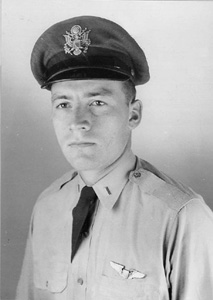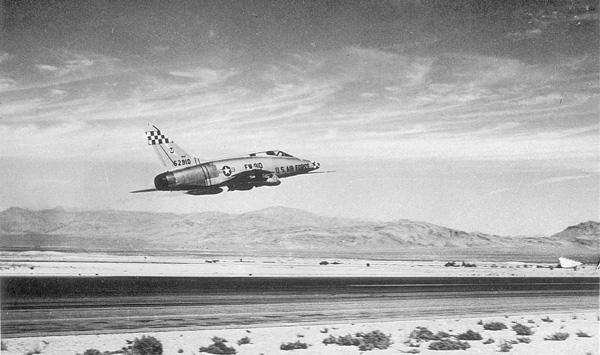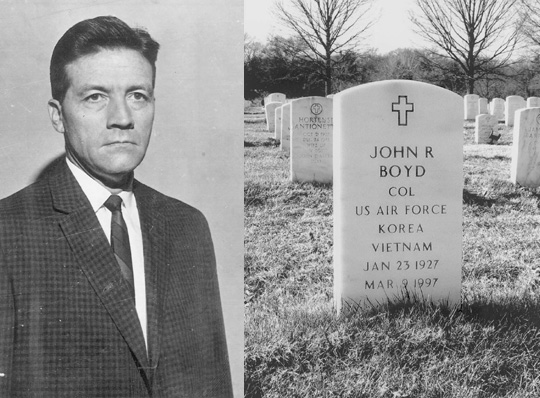Skip to comments.
How a genius fighter pilot improved military strategy (Boyd)
The Atlanta Journal-Constitution ^
| 12/29/2002
| James P. Stevenson
Posted on 12/29/2002 3:46:59 PM PST by FreedomPoster
NONFICTION: Boyd: The Fighter Pilot Who Changed the Art of War. By Robert Coram. Little, Brown & Co. $27.95. 484 pages.
The verdict: Due credit for "one of the most important unknown men of his time."
John Boyd was the smartest man I ever knew; he was also an exemplary leader. If he had asked me to take an 80 percent pay cut to work on a project he could not discuss, I would have committed without question.
His brilliance was exceeded only by his intellectual selflessness. Over the 18 years that he included me in his telephonic ashram, there were periods during which he would spend hours walking me through concepts that I originally believed unfathomable. I learned that coupled with his genius was an ability to break down the most complex into the understandable.
"Boyd was one of the most important unknown men of his time," Robert Coram writes. "He did what so few men are privileged to do: He changed the world. But much of what he did, or the impact of what he did, was either highly classified or of primary concern to the military."
Until I read "Boyd," I thought I knew Boyd. But what I thought I knew were selected bits of confetti. Coram, a former reporter for The Atlanta Journal-Constitution who is best-known for such novels as "Dead South" and "Atlanta Heat," has blended these scraps into a magnificent biography.
Boyd, who died in 1997, was a U.S. Air Force fighter pilot who could not stop thinking about his work. As a captain, he converted fighter-pilot bar talk into the first manual on aerial combat to teach American pilots countermoves to every possible enemy maneuver. Boyd taught himself calculus and at age 33 started work on an engineering degree at Georgia Tech.
It was at Tech that Boyd began to develop his "energy-maneuverability theory," which ultimately changed the way aircraft are designed and enabled America for the first time to assess the combat capability of foreign aircraft.
Boyd was asked to look into the overweight design of the FX, the initial concept for the F-15 Eagle. He used energy-maneuverability to reduce its weight and cost and increase its performance. His follow-up project, the F-16, increased the U.S. Air Force's inventory with the ultimate air-combat fighter.
Boyd went to Vietnam to brief pilots on his energy-maneuverability concepts to more effectively evade surface-to-air missiles. One pilot told me, "I heard Boyd's brief, believed it, and lived. My wingman ignored it and died."
After retirement as a colonel, Boyd refused lucrative offers from industry and donated his time to the U.S. Department of Defense. His thinking evolved from analyzing airplanes and missiles to ferreting out the causes of success in conflict. This led to his seminal work, "Patterns of Conflict," an unpublished, two-day briefing that he gave for almost two decades throughout the military.
Based on Boyd's strategic theories, then-Defense Secretary Dick Cheney rejected the Army's initial Iraqi invasion plan in favor of a modification. Boyd's concepts also prompted the Marine Corps to alter its standard tactics. Its first application was in Desert Storm, during which the only complaint was that the Marines went too fast.
Boyd always told his acolytes, as Coram calls them, that each would have to decide whether they wanted to look back one day at the privileged positions they held or their contributions to their country --- "to do or to be." Putting country first, Boyd told them, would inevitably stall their career. Boyd was an example; his advocacy of doing the right thing instead of toeing the Air Force party line incurred the wrath of senior generals.
It was no surprise then that at Boyd's funeral --- which Coram captures with Kodachrome precision --- the Air Force was represented by a single officer while the Marine Corps attended en masse.
James P. Stevenson is the author of "The $5 Billion Misunderstanding: The Collapse of the Navy's Stealth Bomber Program." He lives in Maryland.
> ON THE WEB: To read the first chapter, go to ajc.com/living/books.
TOPICS: Foreign Affairs
KEYWORDS: boyd; maverick; military; tactics
Navigation: use the links below to view more comments.
first previous 1-20, 21-40, 41-47 next last
To: SmithW
"My personal favorite was the pirouette-down-the-axle."
Very much against my better judgment, I will confess that I have never heard of that one. Go ahead. What is it?
To: Bedford Forrest
Similar to a vertical rolling scissors.
22
posted on
12/29/2002 5:46:59 PM PST
by
SmithW
To: FreedomPoster
There were substantial Marine ground forces deployed along the Persian Gulf coast of Saudi / Kuwait. See the Battle of Khafji, for instance. OK, thanks.
23
posted on
12/29/2002 5:48:59 PM PST
by
Grut
To: Grut
but my recollection is that Marine ground forces weren't used in Desert Storm except as a bluff.The Marine Corps liberated Kuwait City. Both the 1st and 2nd Marine Divisions along with aircraft from the 3rd Marine Air Wing saw plenty of action during Desert Storm. In fact, the Marine Corps moved so fast that the Army's VII Corps and elements of the XVIII Corps had to get into the fight almost 24 hours sooner than planned.
'"I can't say enough about the two Marine divisions. If I use words like "brilliant", it would be an under-description of the absolute superb job they did in breaching the so-called impenetrable barrier. It was a classic, absolutely classic military breaching of a very, very tough minefield, barbed wire, fire-trenches type barrier. They went through the first barrier like it was water. They went across into the second barrier line, even though they were under artillery fire at the same time. They continued to open up the breach. And then they brought both divisions steaming through that breach. Absolutely superb operation, a textbook, and I think it will be studied for many, many years to come as the way to do it."'
Gen. H. Norman Schwarzkopf 27 February 1991 Riyadh, Saudi Arabia
To: Skooz
Likewise. Later reference...
25
posted on
12/29/2002 5:53:46 PM PST
by
OKSooner
To: SmithW
"Similar to a vertical rolling scissors."
Right. Fairly apt description. Rolling scissors in the heavy buffet with the VSI pegged going through ten grand like a pair of anvils - no ego problems in this gaggle- right?
To: Balata
Thanks for the bump.
Boyd is well known and the OODA Loop is quite well know, in the fighter busines and business in general.
He was a great tactician, but when you achieve Flag rank, you now have to think stratgically, and Boyd loved where he was and retired. He would have failed as a general precisely because he couldn't think large enough, which is not an attack on him, just a reality check.
We are all familiar with the "egg" and all that, but with the advent of more powerful fighters, it seems to carry less weight with the young pups out there.
They seem to be all "muscle" and no art. "No problem" they say, "I'll just plug in the blower and have all the energy I need." Right, and you will lose too, as I (an old dog) will not play your game and will use my energy wisely (save gas). I'll be able to stay in the fight while trhe young pups piss away their gas. And then when the young pup has to run away he gets to take a heater up the butt.
Ahhh. . .the memories.
Cheers.
To: backhoe
Worked in Thailand as a tec. rep. for 2 years 67 69 and worked with a Pilot I think was Boyd,, should say talked about a problem with the F4 ejection ,If the Gib got out the pilot could not eject--remembered debriefing two pilot a Col. Finley and , a Chicago Joe---the air flow caused by venturi effect would not allow the the 2000 psi piston to eject canopy---was change to exploive bolts--- I think Boyd was the man that reported Problem---- and recommmend the FIx
To: sphinx; Toirdhealbheach Beucail; curmudgeonII; roderick; Notforprophet; river rat; csvset; ...
Thanks for the ping FreedomPoster
If you want on or off the Western Civilization Military History ping list, let me know!!!!
29
posted on
12/29/2002 9:22:51 PM PST
by
Sparta
To: Sparta
Bump.
30
posted on
12/29/2002 9:34:11 PM PST
by
SAMWolf
To: Sparta
John Boyd - USAF
The Fighter Pilot Who Changed the Art of Air Warfare
by
Robert Coram |
 |
John Boyd in 1952 after winning his wings as an Air Force pilot. After basic flying instruction in Mississippi, he trained in jets at Williams AFB, then combat training in the F-86 at Nellis AFB before being sent to Korea. (Boyd Family Photo) |
During the 1950s John Boyd dominated fighter aviation in the U.S. Air Force. His fame came on the wings of the quirky and treacherous F-100; the infamous "Hun." Boyd was known throughout the Air Force as "Forty-Second Boyd" because he had a standing offer to all pilots that if he could defeat them in simulated air-to-air combat in under 40 seconds he would pay them $40. Like any gunslinger with a name and a reputation, he was called out many times. As an instructor at the Fighter Weapons School (FWS) at Nellis AFB, he fought students, cadre pilots, Marine and Navy pilots, and pilots from a dozen countries who were attending the FWS as part of the Mutual Defense Assistance Pact.
He never lost.
Boyd was famous for a maneuver he called "flat-plating the bird." He would be in the defensive position with a challenger tight on his tail, both pulling heavy Gs, when he would suddenly pull the stick full aft, brace his elbows on either side of the cockpit so the stick would not move laterally, and stomp the rudder. It was as if a manhole cover were sailing through the air and then suddenly flipped 90 degrees. The underside of the fuselage, wings, and horizontal stabilizer became a speed brake that slowed the Hun from 400 knots to 150 knots in seconds. The pursuing pilot was thrown forward and now Boyd was on his tail radioing "Guns. Guns. Guns."
The myth of "Forty-Second Boyd" still rankles AF fighter pilots. They say there is no "best" pilot; that everyone has a bad day. But if they went through Nellis in the late 1950s, they know Boyd had no bad days. And they cannot come up with the name of anyone who ever defeated him.
Boyd was equally famous in the classroom where he developed the "Aerial Attack Study." Until Boyd came along, fighter pilots thought that air combat was an art rather than a science; that it could never be codified. Boyd proved them wrong when he demonstrated that for every maneuver there is a series of counter maneuvers. And there is a counter to every counter. Afterwards, when fighter pilots attacked (or were attacked), they knew every option open to their adversary and how to respond. |
 |
| An F-100 taking off from Nellis AFB circa 1959. Note checkerboard pattern on the vertical stabilizer and nose. This indicates it was a "Hun" from the Fighter Weapons School. It was in the Hun that Boyd became famous as "Forty-Second Boyd," the man who defeated all challengers in simulated air-to-air combat in less than 40 seconds. (USAF Photo) |
After the study was declassified, foreign pilots passing through Nellis took it home where it changed the way every air force in the world flies and fights. Even today, more than 40 years later, nothing substantial has been added to the Aerial Attack Study.
After a six-year assignment at Nellis, Boyd returned to college for another undergraduate degree. He went to the Georgia Institute of Technology where, one night while studying for an exam in thermodynamics, he had the epiphany that became his famous Energy-Maneuverability Theory, or E-M Theory, as it came to be known.
The E-M Theory changed everything that everyone thought they knew about fighter combat. It enabled fighter pilots to evaluate their energy potential at any altitude and at any maneuver. And, perhaps more importantly, the energy potential of their adversary. It changed forever the way aircraft are fought in combat.
Boyd then used E-M as a design tool. Until E-M came along, fighter aircraft had been designed to fly fast in a straight line or fly high to reach enemy bombers. The F-X, which became the F-15, was the first Air Force fighter ever designed with maneuvering specifications. Boyd was the father of the F-15, the F-16, and the F-18.
America has dominated the skies for the past 30 years because of John Boyd.
After he retired, he developed a theory of combat that, according to Vice President Dick Cheney who was Secretary of Defense at the time, was responsible for America's swift and decisive victory in the Gulf war. |
 |
| John Boyd after retiring from the Air Force. (Boyd Family Photo) |
John Boyd's grave in Arlington National Cemetery, Section 60, gravesite 3660. He was buried in March, 1997.
(Photo by Chet Richards) |
But it is as a fighter pilot that many retired Air Force officers today remember John Boyd.
For the past three years I have been researching Boyd's life for a biography titled "Boyd: The Fighter Pilot Who Changed the Art of War." It will be published by Little, Brown and Company in November. The chapters covering Nellis in the 1950s will be of much interest to fighter pilots. |
31
posted on
12/29/2002 9:59:00 PM PST
by
dennisw
To: dennisw
Thanks; I assume that's the book excerpt that was promised?
In any case, it's cool to know he was a fellow GA Tech grad. While I certainly enjoyed Thermo, I never had any epiphanies while studying it. In fact, I used to read my Thermo book if I wanted to fall asleep. ;-)
FP
GT BME '82
GT MSME '85
To: FreedomPoster
actually, here's the
first chapter on-line ... interesting reading, I want more.
33
posted on
12/30/2002 4:35:30 AM PST
by
fnord
To: Skooz
Another book on the "must read before I die list."
So many books....so little time.
OTOH think of the library heavens got!
34
posted on
12/30/2002 4:53:12 AM PST
by
Valin
To: FreedomPoster
Good photos of the man and his airplane!
35
posted on
12/30/2002 5:12:41 AM PST
by
dennisw
To: FreedomPoster
Now this has me wondering..............
As an AF Academy cadet in the mid '70's, I took a course taught by a particular Captain whose name now eludes me. This was a fascinating course that was, in effect, a class on "problem solving techniques". It was, hands down, one of the best courses I ever took. The "strawman" technique of building a solution, then tearing it down until very little remained......only to begin rebuilding your solution yet again, repeating this painful process over and over........was incredibly powerful.
The Captain had been a protege' of a Colonel who this Captain claimed to be the "father of the lightweight fighter program". The man was, apparently, a true genius......and my instructor couldn't say enough about him. I'm wondering if it was Boyd.
IF it was Boyd, two interesting tidbits passed on to us by the good Captain.
A) The Colonel once said that he could develop the best tank on earth.............because he knew absolutely nothing whatsoever about tanks.
B) The Colonel used to delight in the fact that his measured IQ was only 85. You read that right...........85.
To: RightOnline
The Colonel used to delight in the fact that his measured IQ was only 85. You read that right...........85. IIRC, the AF's minimum IQ for commissioning was 115, so I kind of doubt that. Besides, in that case he'd have made General.
37
posted on
12/30/2002 5:32:05 AM PST
by
Grut
To: Grut
I was commissioned and my IQ was never measured. To the best of my knowledge, there has never been a "minimum IQ" prerequisite for commissioning.
To: Poohbah; section9; mhking
FYI ping.
39
posted on
12/30/2002 5:37:43 AM PST
by
hchutch
To: backhoe
bump for later
Navigation: use the links below to view more comments.
first previous 1-20, 21-40, 41-47 next last
Disclaimer:
Opinions posted on Free Republic are those of the individual
posters and do not necessarily represent the opinion of Free Republic or its
management. All materials posted herein are protected by copyright law and the
exemption for fair use of copyrighted works.
FreeRepublic.com is powered by software copyright 2000-2008 John Robinson


